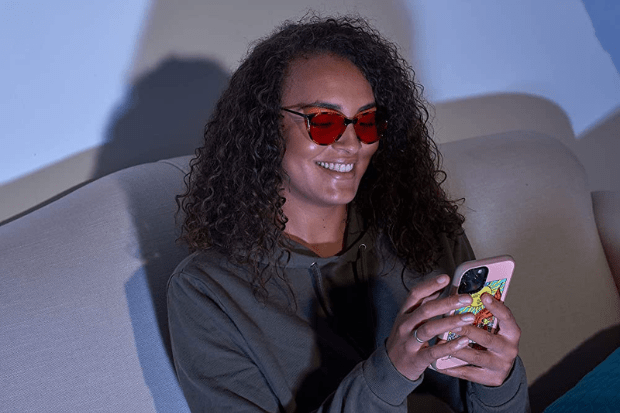FL-41 Glasses VS. Blue Light Glasses

FL-41 glasses and blue light glasses have different types of tinted lenses and are used for different purposes. Fl-41 glasses are a type of blue-light blocking lens that block a wider range of the light spectrum. Each type of lens is prescribed by a doctor for a patient’s specific symptoms. We will look at the benefits and drawbacks of both FL-41 glasses and blue light glasses and which lens type is best for a patient’s ocular symptoms.
Benefits of FL-41 Glasses
Improvements in light sensitivity and functional vision in cases of TBI, migraine patients, or those with blepharospasm are benefits of FL-41 glasses.
Improves Light Sensitivity
FL-41 lenses can improve the symptoms of those who suffer from migraines or a TBI.
Migraines
Children with a history of migraine headaches report a reduction in the frequency of their migraine headaches from 6.2x per month to 1.6x per month with FL-41 lenses but report blue light lenses had no effect on their symptoms.
Traumatic Brain Injury (TBI)
After a blast related-concussion or head trauma, 60-70% of soldiers experience light sensitivity. FL-41 glasses are helpful in managing the symptoms of TBI, like asthenopia, squinting, dry eyes, and headaches. Those with a history of a concussion due to a car accident or sports injury may also experience an improvement in symptoms with the use of FL-41 glasses.
Improves Functional Vision
Functional vision is how an individual performs while interacting with the visual environment. FL-41 lenses improve functional vision in patients with blepharospasm.
Blepharospasm
Blepharospasm is the involuntary, spasmodic closing of the eyelids; it can be on one side of the face or both sides. Studies demonstrate that FL-41 tinted lenses improve reading, fluorescent light sensitivity, overall light sensitivity, blepharospasm frequency, and severity. They also reduced the blink rate and improved the blepharospasm more than with the use of rose and gray-tinted lenses.
Drawbacks of FL-41 Glasses
Blocking a wide range of light wavelengths and changing the shade of colors are potential drawbacks to FL-41 glasses.
Blocks Wide Range of Wavelengths
FL-41 glasses block a wide range of blue to green light. Some studies show green light may have benefits for migraine sufferers. As recently as 2021, researchers report that while blue light may incite a migraine, green light significantly reduced the number of headache days in people with migraines. Green light therapy also improves the quality of life and the intensity and duration of the headaches for study participants.
Changes Shades of Color
FL-41 glasses have a BPI proprietary rose color tint and will change the appearance of the world around you. If you are an artist or a graphic designer, the color tint may be a hindrance to your work.
Benefits of Blue Light Glasses

Improvements in eye strain and sleep are two possible benefits of the use of blue light glasses.
Improve Eye Strain
90% of those who use a computer 3 hours or more a day suffer from Computer Vision Syndrome (CVS), also called Digital Eye Strain (DES). The non-specific symptoms include eye fatigue, eye strain, pain in and around the eye, blurred vision, headaches, and even diplopia (double vision). Asthenopia and dry eye are the primary symptoms of CVS. While using blue light glasses alone is unlikely to resolve eye strain, they may be a potential therapy.
Improve Sleep
Exposure to blue light is important for an individual’s “well-being, alertness, and cognitive performance” during the day, but chronic exposure to low-intensity blue light prior to bedtime may affect sleep quality, sleep phase, and sleep cycle durations. After a review of many sleep studies, there was evidence that blue-light glasses may be beneficial for patients with sleep disorders, jet lag, or variable shift work schedules.
Drawbacks of Blue Light Glasses
It is still unknown whether the symptoms of eye strain and headaches can be improved with blue light glasses. Evidence is unclear as to the specific benefits.
May Not Improve Eye Strain
While blue light glasses may have some effect on eye strain, improving ergonomics may be more important. Experts recommend computer users follow the 20-20-20 rule, sit 25 inches away from the monitor, reduce screen glare, and take more frequent breaks.
May Not Improve Headaches
It has been demonstrated that blue light exposure can have an effect on those with a history of migraine headaches. Exposure seems to increase discomfort, the perception of pain and throbbing, and the spread of pain across the head. However, not all headaches are migraine headaches, so consultation with your eye doctor and neurologist is important to decide if blue light glasses are the best therapy for you.
Variations in Hue
Similar to FL-41, most blue light glasses have a yellow to amber hue. This tint can change the color of your environment, computer screen, or design work. If identifying or determining color is key for your occupation, you may prefer no tint and an anti-reflective coating with little to no color.
Comparison table of FL-41 Glasses and Blue Light Glasses
Both types of lenses have unique benefits for a patient’s specific visual symptoms. Both FL-41 glasses and blue light glasses are available with your prescription at Overnight Glasses.
| Type of Glasses | Primary Symptoms | Ocular Conditions | Filtered Wavelengths | Tint Color |
|---|---|---|---|---|
| FL-41 | Light Sensitivity, Headaches | Migraines, Blepharospasm, Concussions |
Blue to green 480-520 nanometers (nm)* |
Rose |
| Blue Light | Eye Fatigue, Blurred Vision, Dry Eye |
Digital Device Users, Insomniacs |
Blue to purple 400- 480 nanometers (nm)* |
Amber to Yellow |
| Comparison | FL-41 | Blue Light |
|---|---|---|
| Primary Symptoms | Light Sensitivity, Headaches | Eye Fatigue, Blurred Vision, Dry Eye |
| Ocular Conditions | Migraines, Blepharospasm, Concussions | Digital Device Users, Insomniacs |
| Filtered Wavelengths | Blue to green 480-520 nanometers (nm)* | Blue to purple 400- 480 nanometers (nm)* |
| Tint Color | Rose | Amber to Yellow |
* The range of filtered wavelengths vary slightly per source
Final Thoughts:
Both FL-41 and blue light glasses have different tints designed to block specific wavelengths of light. FL-41 glasses are best for light sensitivity and improving visual function for patients with ocular conditions like blepharospasm, migraines, or a history of TBI. On the other hand, blue light lenses are best for digital device users who suffer from computer vision syndrome and symptoms of eye fatigue, dry eye, and blurred vision. Lastly, there is potential they may improve sleep in those with sleep disorders, jetlag, and night-shift workers.
